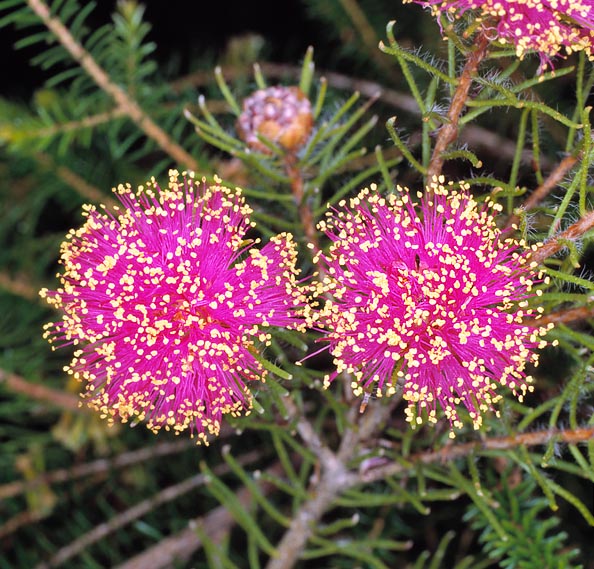Family : Myrtaceae

Text © Pietro Puccio

English translation by Mario Beltramini

The Melaleuca trichophylla is an Australian shrub with a horticultural Mediterranean future © G. Mazza
The name is the combination of the Greek terms “melas” = black, and “léukos” = white, with reference to the colour of the bark, initially white and then becoming black while ageing; the name of the species is the combination of the Greek terms “trichos” genitive of “thrix” = pilus, hair and “phyllon” = leaf, with reference to the leaves, covered by thick hair.
Common names: pretty honey myrtle (English).
The Melaleuca trichophylla Lindl (1839) is an evergreen shrub, 0,2-1 m tall, with a rather variable posture, from prostrate to erect, with alternate, filiform, leaves, 2,5-3,5 cm long, arcuate, pointed, covered by thick hair.
The inflorescences are hemispheric, compact, terminal and axillary spikes, with woolly rachis and flowers with 5 sepals and petals hidden by a crowd of stamina, united at the base, of purple pink colour with yellow anthers. The fruits are globose capsules of 0,5 cm of diameter, containing tiny seeds.
It reproduces by seed, in sandy substratum, and by woody cutting in summer. It is a much ornamental species during the flowering period, but practically unknown outside the origin area where it grows in full sun on sandy or stony soils perfectly draining, from acidic to slightly alkaline, in purely Mediterranean-type climate with almost no rainfall in summer and mild, relatively rainy, winters, with temperatures which only exceptionally can go down to some degrees below 0 °C.
During the flowering time, it feeds a fair trade of cut flowers, collected directly in nature.
→ To appreciate the biodiversity within MYRTACEAE family please click here.
